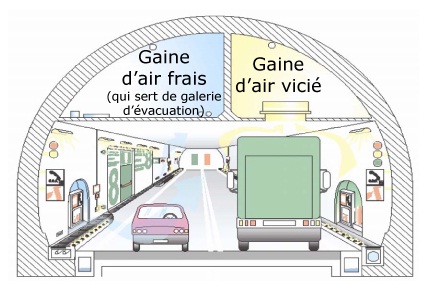Safety
Before entering the tunnel:
The main risk in tunnels is that of an HGV catching fire. The tragedy of the Mont Blanc tunnel is a cruel reminder that the smoke resulting from fires is far more dangerous than the flames.
- Check that you have enough fuel in your tank before entering the tunnel.
Please note: if you have to be assisted because you run out of fuel inside the tunnel this will cost at least 300 € (light vehicles) or 1500 € (HGVs and coaches). In the event of breakdown due to a mechanical problem you will be assisted free of charge.
- Switch on your dipped headlights.
- Comply with traffic signals (variable message signs, traffic lights, etc.).
- IF THE TRAFFIC LIGHTS TURN RED stop immediately, keeping a distance of 100 m from the vehicle in front of you.
- Listen to FM radio (107.7 in France and 103.3 in Italy).
- Keep a distance of at least 150 m from the vehicle in front of you. 150 metres is equivalent to the distance between two of the blue road-level lights
- Stick to the speed limit (minimum 50 km/h, maximum70 km/h).
Equipment and infrastructure
The Fréjus tunnel was designed for HGVs up to 4.3 metres high. A single tunnel bore houses two lanes of traffic each 3.5 metres wide, with a total usable width of 9 metres. Five garages and five turning galleries situated opposite each other every 2,100 metres make it possible to pull over in an emergency and to evacuate vehicles that have broken down.
The central control station of the Fréjus tunnel constantly monitors the tunnel in real time. This single control station is located on the Italian side and permanently monitors the tunnel infrastructure. It is manned 24 hours a day by one controller and one operator.
The tunnel is equipped with numerous safety installations: SOS buttons every 20 metres, 100 call niches, located every 265 metres and containing two fire extinguishers, two additional fire extinguishers between every niche, and fire hydrants every 130 metres. The tunnel contains 11 pressurized shelters connected to the ventilation duct, which at present is the escape route used to evacuate tunnel users.
It is further fitted with “fire-wall” manholes, by which it is possible to prevent a fire from spreading through the drainage gutters when flammable material flows on to the road.
Two ventilation ducts run above the concrete ceiling slab of the tunnel: one evacuates used air or smoke, the other brings in fresh air and can also be used to evacuate persons from the tunnel in the event of a fire.
The tunnel is supplied with fresh air by six ventilation stations: one at either end of the tunnel and two double stations underground, one of which is located on the French side 4 km from the tunnel mouth, and the other on the Italian side, 8 km from the French tunnel mouth.
Every station renews the air of a 2,140 metre long ventilation section. The two underground stations are supplied with fresh air by two shafts opening to the outside 2,000 metres above sea level. The fresh air supply is subject to information supplied by pollution sensors, which measure air opacity, wind speed and carbon monoxide levels.
Two power networks supply the tunnel: the Italian ENEL network for the direction France/Italy, and the French company EDF in the direction Italy/France. For example, for every pair of ventilators one is supplied with power by ENEL and the other by EDF. In the event of a power outage, either network can take over from the other one. If both power supply sources were to break down, generators are provided to ensure that systems essential for safety continue to function. The tunnel interior is lit up by more than 3,000 light fittings.

